Astronomy in Korea
Astronomy in Korea
Before the 20th Century History
Historical Astronomy of Korea
Dr. Hong-jin Yang
Korea Astronomy & Space Science Institute (KASI) /
Institute for Korea history of Astronomy (IKHA)
lntroduction
Astronomy, along with mathematics and medical science, is one of the oldest fields in the history of humanity’s pursuit of knowledge. Aside from China, Korea is the country with the longest history of astronomy in the world. To meet the need for an astronomical almanac to assist agriculture, Korea’s ancestors developed astronomical observatories and astronomical instruments for studying celestial bodies and left behind many historical artifacts and a rich heritage in the field of astronomy. Although many of these inheritances have disappeared or were destroyed due to repeated foreign invasions and wars, many artifacts of Korea’s historical astronomical heritage still remain preserved. Among these, the representative historical items include astronomical calendars, astronomical observatories, observational instruments, astronomical charts, and astronomical records from various periods of the country’s history. Korea’s historical books include a total of around 25,000 records on astronomical observations, compiled based on Koreans’ steady and systematic observation of the skies over the course of over two millennia. These records of astronomical observation are not only significant for historians of science as a testament to the excellence of Korea’s traditional science, but are also employed as important data in contemporary astronomical research. The outlines of these astronomical records sometimes provide crucial clues to studies on stellar explosions, comets’ orbits, and abnormal astronomical phenomena that took place in the past. Korea’s historical chronicles even include observations that have recorded nowhere else in the world, and the value of these records is demonstrated by an actual example: contemporary research conducted based on the observation of a stellar explosion recorded in Goryeosa, a history of the Goryeo dynasty period, was recognized for its outstanding contribution and published as the cover article of one of the world’s leading academic journals. Korea’s historical astronomy serves as proof of Korea’s outstanding scientific achievements in the past while simultaneously providing useful research material for contemporary astronomers, and the study of historical astronomy has come to be recognized as a significant field within contemporary astronomy.
Korea's Historical heritage in Astronomy
Prehistoric period of Korea
Although Korea boasts a long history of traditional astronomy and is home to many historical astronomical artifacts, there had been few initiatives to study the astronomy of the prehistoric period. Cheomseongdan, an astronomical observatory site located on Mt. Manisan on Ganghwa island, and the cup-marks inscribed on dolmens are some of the representative artifacts of Korea’s astronomical heritage dating from the prehistoric period. The Mt. Manisan Cheomseongdan is known to have been a site where ceremonial rites were conducted to honor the sky and the stars, and it retains one of the oldest existing traces of Korea’s astronomical history. The structural form of Cheomseongdan was built to reflect the ancient Asian cosmological belief that the sky is round and the earth is square, and there remain records of astronomical observations that were conducted at this same site by royal astronomers even up to the Joseon dynasty period (A.D. 1392-1910) (Rufus, 1936).
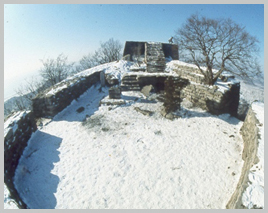 ▲ Cheomseongdan on Mt. Manisan in Ganghwa island
▲ Cheomseongdan on Mt. Manisan in Ganghwa island
 ▲ The constellations recorded on the Adeukgi dolmen's surface (UMi, Dra, Big Dipper). The image of the inscriptions in reverse shown on the right (C. Park et al., 2001)
▲ The constellations recorded on the Adeukgi dolmen's surface (UMi, Dra, Big Dipper). The image of the inscriptions in reverse shown on the right (C. Park et al., 2001)
Many dolmens, which comprise the representative style of tombs built during the Bronze Age in Korea, have been found inscribed with images of the constellations. Various forms of cup-marks have been discovered on the capping stone covering the dolmens, which are located throughout the Korean peninsula, and several researchers have identified these inscribed marks as images of constellations. Research conducted in Europe and North Korea have already drawn attention to the dolmens’ relation to astronomy, and images of constellations were reported to have been found in the cup-marks on several dolmens. Initiatives to study the dolmens in Korea, where there is the largest number of dolmens in the world, gained momentum in the late 1990s. It was in 2001 that researchers first discovered constellations including the Big Dipper, the Ursa Minor, the Draconis, etc. inscribed on the stone plate surface of the Adeukgi dolmen. Thereafter, investigative reports identified many dolmens in Korea inscribed with constellation marks, with various patterns including representations of the Big Dipper, Sagittarius, the Pleiades cluster and Corona Borealis, etc. The results of a study of the distribution of inscription marks on dolmens in Korea confirmed that the distribution of the cup-marks among dolmens in South Korea coincided with the astronomical orientation (southeastern direction) which had earlier been found to exist among artifacts of megalithic culture in Europe.
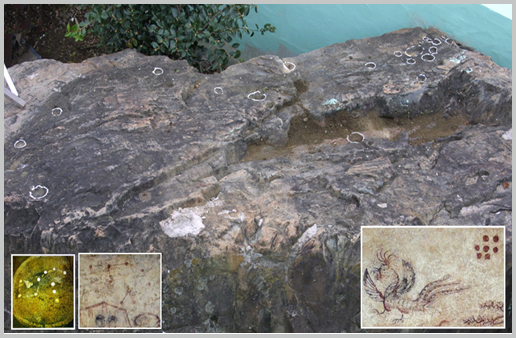 ▲ Cup-marks on the dolmen in Yachon-ri, Haman, inscribed with such constellations as the Three Star, the Sagittarius and the Pleiades. Inserted images at the bottom are constellation appearing on the wall paintings of ancient tombs (Yang, 2004; C. Park, 2008)
▲ Cup-marks on the dolmen in Yachon-ri, Haman, inscribed with such constellations as the Three Star, the Sagittarius and the Pleiades. Inserted images at the bottom are constellation appearing on the wall paintings of ancient tombs (Yang, 2004; C. Park, 2008)
In addition, various studies in the humanities have explored the possibility that rock paintings and inscriptions discovered on natural rock formations may have astronomical origins, and astronomical analyses of various astronomical records found in ancient history books such as Handangogi, etc. are also currently in progress.
The Three Kingdooms period (57 B.C. - A.D.935)
There are a relatively large number of astronomical heritage artifacts that date from the Three Kingdoms period. Samguksagi (the official history book of the Three Kingdoms period) is a representative text that contains records of the history of the three kingdoms known as Silla (57 B.C.- A.D. 935) Goguryeo (37 B.C.-A.D. 668) and Baekje (18 B.C.-A.D. 663), and this book includes 240 records of astronomical phenomena, including solar and lunar eclipses, planetary movements, meteors and meteor showers, sunspots, etc. By applying numerical algorithms in relation to celestial bodies, it has been verified that these records are factual accounts of actual astronomical phenomena and that these Korean historical texts contain observations and records made independently of those found in China and Japan.
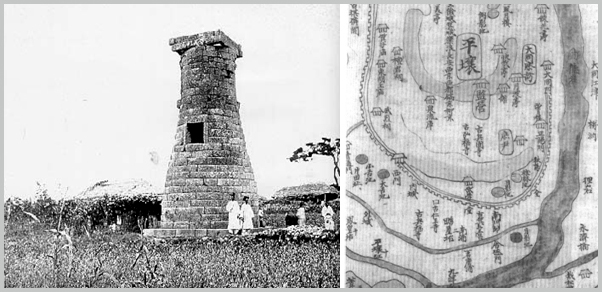 ▲ Cheomseongdae in Gyeongju (left) and Goguryeo Cheomseongdae on a map of Pyeongyang (right)
▲ Cheomseongdae in Gyeongju (left) and Goguryeo Cheomseongdae on a map of Pyeongyang (right)
In Gyeongju, the capital city of the Silla kingdom, there remains an astronomical observatory tower in the shape of a curved bottle, with a height of around 9 m. The Gyeongju Cheomseongdae was built during the 2nd year of the reign of Queen Seondeok (A.D. 633) and is the oldest standing astronomical observatory in the world. Deducing from the numerous astronomical records contained in history books from this era, it is likely that the kingdoms of Baekje and Goguryeo also had observatories designed for professional research of stars, but no traces of these constructions remain. The only existing evidence of an observatory in Goguryeo is provided by the annals of the reign of King Sejong from the Joseon dynasty, which records that an astronomical observatory had existed south of Pyeongyang in the kingdom of Goguryeo, and by a map of Pyeongyang which indicates the location of this observatory. Meanwhile, although there are no surviving records of an observatory in the kingdom of Baekje, many scholars in the field of ephemeris and astronomy were dispatched from Baekje into Japan to disseminate Baekjae’s advanced knowledge of astronomy.
24 of the murals found in the tombs of Goguryeo have been reported to include images pertaining to astronomy, such as the Sun, the Moon and the constellations. These ancient tomb murals from the Goguryeo kingdom are evidence that the system of organizing the constellations into 3 “enclosures” and 28 “mansions”, a system that originated from China, was firmly established in Korea as early as the Three Kingdoms Era. Particularly good examples that demonstrate the astronomical system of this era are the images of stars found in the No.4 tomb in Jinpa-ri, and the tomb in Deokheung-ri. Although these images rely on the constellation system introduced from China, the constellations painted in the tombs of Goguryeo illustrate features of constellation distributions unique to the Korean peninsula, such as the positioning of the Big Dipper and the Sagittarius respectively in the north and south. Also, it has been found that there are many common features shared between the numerous constellation images painted in Goguryeo tombs and the astronomical cup-marks of dolmens, and this indicates that the original knowledge and system of astronomy developed in Korea passed on with continuity from the Bronze Age into the Three Kingdoms period.
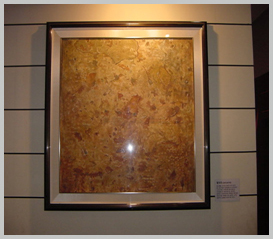 ▲ No.4 tomb in Jinpa-ri
▲ No.4 tomb in Jinpa-ri
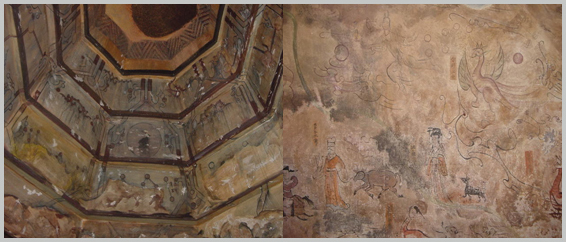 ▲ Tombs in Deokhwa-ri (left) and Deokheung-ri (right), the latter of which shows stars as well as mythical figures.
▲ Tombs in Deokhwa-ri (left) and Deokheung-ri (right), the latter of which shows stars as well as mythical figures.
Goryeo dynasty (918 - 1392 A.D.)
Comparable to the Silla kingdom’s astronomical observatory that remains in Gyeongju city, there also remains a royal astronomical observatory from the Goryeo dynasty period. Goryeo’s royal observatory is preserved in the city of Gaeseong in North Korea in a partially damaged condition. Currently, the observatory remains standing in the form of five stone pillars 3 m in height covered with a stone plate with each of the four sides measuring 3 m, and the vicinity is scattered with many stone pillars that are thought to have fallen away from the observatory itself. The Gaeseong observatory is evidence that the institution of royal astronomical observatories that existed during the Three Kingdoms period (as seen in the Gyeongju observatory) continued during the Goryeo dynasty. As in the case of constellation images found in the tombs of the Goguryeo kingdom, the paintings of stars are also preserved in tombs from the Goryeo dynasty. The leading example of such star paintings from the Goryeo dynasty period is found in Seosamdong, in the city of Andong, where the ceiling of the tomb is replete with images of the Big Dipper and the 28 stellar mansions. The constellation images in the Seosamdong tomb confirms that the tradition of painting stars in tombs was passed on from the Bronze Age to the Goguryeo kingdom and well on into the Goryeo dynasty.
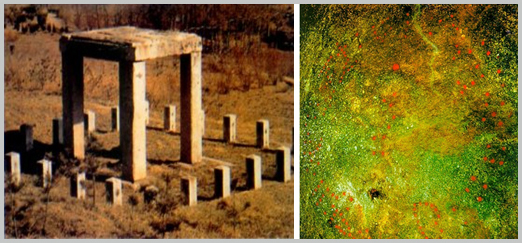 ▲ Remains of the Gaeseong observatory (left) and a tomb painting in Seosamdong, Andong (right)
▲ Remains of the Gaeseong observatory (left) and a tomb painting in Seosamdong, Andong (right)
The chronicles of Goryeo history found in Goryeosa (the official history book of Goryeo dynasty) contain 5000 astronomical records systematically organized according to the classification of astronomical phenomena. Particularly notable within the book Goryeosa are thesections entitled “Cheonmunji” and “Ohaengji”, which present records of solar and lunar eclipses, meteors and meteor showers as well as sunspots and auroras categorized by time period. Contemporary astronomers are utilizing these records of sunspots, auroras, guest stars and meteor showers, etc. preserved in Goryeosa as important information for modern astronomical research. Analyses of these actual historical records of astronomical data have confirmed that sunspots and auroras in the Goryeo period exhibited a period of 11.3 years as well as an additional longer period of approximately 97 years, and the records of meteor showers have allowed researchers to identify changes in the activities of periodic comets over the last millennium. Moreover, Korean history books provide the only existing records of two stellar explosions that occurred respectively in 1073 and 1074, and this important evidence enabled researchers to unravel clues to the physical properties of R Aqi in Aquarius and present their findings at an international conference.
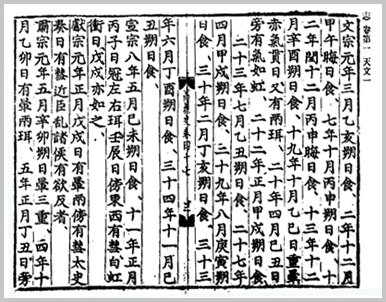 ▲ Observational records in Cheonmunji section of Goryeosa
▲ Observational records in Cheonmunji section of Goryeosa
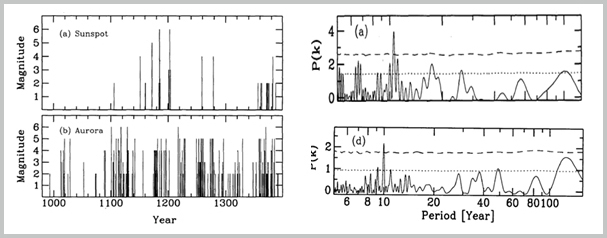 ▲ Distributions of the sunspots and auroras recorded in the Goryeo Dynasty period (left) and an analysis of their cycles (right)
▲ Distributions of the sunspots and auroras recorded in the Goryeo Dynasty period (left) and an analysis of their cycles (right)
Joseon Dyansty (1392 - 1897 A.d)
The greatest number of historical records and artifacts relevant to astronomy date from the Joseon dynasty. Joseonwangjosillok (the official chronicles of Joseon dynasty), which serves as the most important historical record of this period, offers us detailed records of approximately 20,000 items of astronomical phenomena, organized by time period. Compared to previous eras, the astronomical records of Joseon are both more abundant in quantity and more specific in detail, offering important observation data for contemporary scholars engaged in astronomical research. Multiple royal observatories existed during the Joseon dynasty. According to records, in addition to the major observatory called “Daeganeudae” that was located to the north of Gyeongbok Palace, there were also three smaller observatories called “Soganeudae,” and these observatory towers were referred to as “Gwancheondae.” However, the only observatories that remain today are the two respectively located in Changgyeong Palace and in front of the Hyundai Group’s corporate building. The records from the Joseon dynasty include not only references to these observatories, but also records of astronomical phenomena observed in various regions of the provinces.
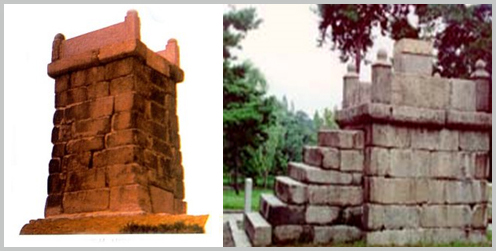 ▲ Gwanghwabgang Gwancheondae (left) and Soganeudae (or Gwancheondae) in Changgyeong Palace (right)
▲ Gwanghwabgang Gwancheondae (left) and Soganeudae (or Gwancheondae) in Changgyeong Palace (right)
There are records of numerous scientific instruments used during the Joseon dynasty for the purposes of astronomical observation, including “Honui” (an armillary sphere), “Honsang” (a celestial globe), “Ganui” (a simplified armillary sphere), “Ilseongjeongsiui” and “Gyopo,” (a gnomon), etc. The development of these astronomical instruments enabled precise observations of celestial bodies and made possible the creation of a unique calendar system known as “Chiljeongsan” during the reign of King Sejong. In addition, numerous astronomical books and observational logs listing astronomical data have been preserved from this period. Examples of such astronomy publications that testify to the flourishing of astronomical knowledge during the Joseon dynasty include the book entitled “Cheonmunryucho,” the first book of astronomy in Korea, “Jegayeoksangjip,” “Seonggyeong,” as well as compilations of astronomical observations such as “Seongbyeoncheukhudanja” (a daily observational record) and “Seongbyeondeunrok.”
<
An astronomical chart is a culminating work of knowledge that testifies to the level of astronomical observation attained in a particular era. The astronomical chart entitled “Cheonsangyeolchabunyajido” is a representative example preserved from the Joseon dynasty, and has been designated as Korea’s National Treasure No. 228. This astronomical chart, created in 1395, illustrates 1467 stars and indicates the movements of the Sun and the Moon, the positions of the constellations, and gives an account of the circumstances that motivated the creation of the chart. This chart is known to have been created to provide continuity with a stone-inscribed astronomical chart that dated from the Goguryeo kingdom: after the disappearance of this stone-inscribed Goguryeo astronomical chart, a copied record of the missing chart was found, which provided the basis for the creation of this new chart in the early years of the Joseon dynasty. “Cheonsangyeolchabunyajido,” in contrast to “Suzhou stone star chart” created by China in 1247, is a very scientific astronomical chart that displayed individual stars with differing sizes in proportion to their respective brightness. There are numerous other printed or manuscript astronomical charts from this period, including “Honcheonjeondo,” created after the introduction of Western astronomy in Korea, and “Hwangdonambukseongdo.”
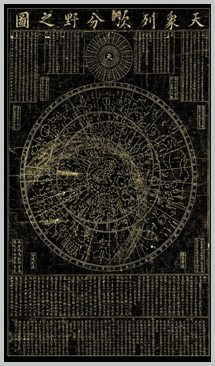 ▲ A stone-inscribed astronomical chart, Cheonsangyeolchabunyajido
▲ A stone-inscribed astronomical chart, Cheonsangyeolchabunyajido
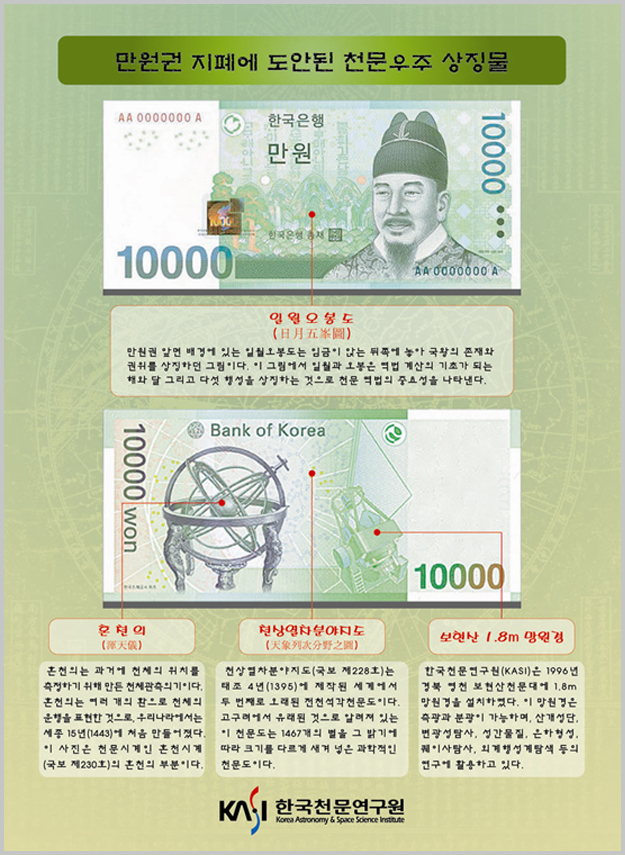 ▲ Symbols related to astronomy and universe on the 10,000 won Bill of the Republic of Korea
▲ Symbols related to astronomy and universe on the 10,000 won Bill of the Republic of Korea
(Top) "Ilweolobongdo" (painting with the Sun, the Moon and five peaks)
The "Ilweolobongdo" that forms the background of the front of the 10,000 won bill was a painting that was placed behind the royal seat, symbolizing the presence and authority of the monarch. "Ilweol" and "obong" refer respectively to the symbols for the Sun and Moon and the five planets, which were the basis of the calendar system, indicationg the importance of the ephemeris.
(Bottom left) "Honcheonui" (armillary sphere)
The "honcheonui" was an instrument of astronomical observation that was used in the past to measure the locations of celestial bodies. The honcheonui used multiple circles to describe the movements of objects in the sky. In Korea, it was made for the first time in the 15th year of the reign of King Sejong (A.D. 1443). The image on the bill shows the armillary sphere that forms a section of the "honcheonsigae" (armillary clock), an astronomical clock that has been designated as National Treasure No. 230 of Korea.
(Bottom middle) "Cheonsangyeolchabunyajido" (astronamical chart)
The astronomical chart entitled "Cheonsangyeolchabunyajido" (National Treasure No. 288 of Korea) was created in the 4th year of the reign of King Taejo (A.D. 1395). It represents a stone-inscribed astronomical chart of the entire sky, the second oldest existing example of its kind in the world. This astronomical chart is known to have originated from the Gohuryeo kingdom, and is a scientific representation in which 1467 starts are inscribed with differing sizes according to their relative brightness.
(Bottom right) The 1.8m telescope at Bohyeonsan
In 1996, the Korea Astronomy and Space Science Institure (KASI) installed a 1.8m telescope at the Bohyeonsan Observatory located in Yeongcheon, Gyeongsangbukdo Province. The telescope is capable of photometry and spectroscopy, and is used for research exploring open clusters, variable stars, galaxy formations, quasars, and extra-solar planetary systems, etc.